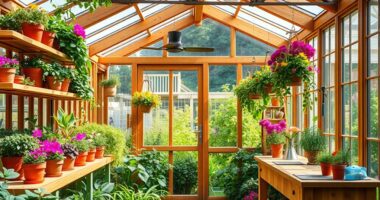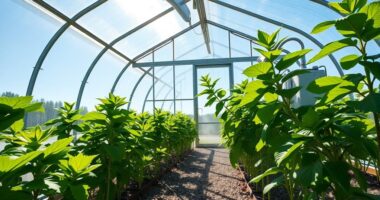Your greenhouse ventilation system combines fans, vents, and cooling methods to keep air flowing smoothly and maintain ideal conditions. Fans help circulate air, while vents allow you to control the exchange between inside and outside environments. Cooling options, like shaded vents or exhaust fans, prevent overheating. Properly integrating these components ensures healthy plant growth by reducing humidity, preventing mold, and balancing temperature. Keep exploring to discover more ways to enhance your greenhouse environment effectively.
Key Takeaways
- Fans promote uniform airflow, helping regulate temperature and humidity levels inside the greenhouse.
- Vents enable controlled exchange of indoor and outdoor air, preventing stagnation and excess moisture.
- Automated systems optimize ventilation, maintaining consistent environmental conditions with minimal manual effort.
- Proper placement of fans and vents ensures effective air circulation throughout all greenhouse areas.
- Combining fans, vents, and cooling methods reduces energy costs while enhancing plant health and growth.

Have you ever wondered how clean, fresh air circulates through buildings? It’s all about effective ventilation systems that manage airflow and humidity, especially in environments like greenhouses where maintaining optimal conditions is vital. Proper airflow management ensures that fresh air reaches every corner, preventing stale air from stagnating and reducing the risk of mold or plant diseases. When you design or upgrade your greenhouse ventilation, you’re directly controlling how air moves in and out, which impacts temperature, humidity, and overall plant health. By ensuring good airflow, you give your plants the environment they need to thrive, while also reducing energy costs associated with cooling or heating. Incorporating air exchange systems can further optimize air quality and energy efficiency in your greenhouse. Humidity control is another significant aspect of ventilation systems. Too much moisture can lead to fungal problems and rot, while too little can stress your plants and hinder growth. Ventilation helps regulate humidity levels by removing excess moisture and bringing in drier air when needed. This balance is essential because it creates a stable environment where plants can grow vigorously without the risk of disease. Using fans and vents strategically allows you to adjust humidity levels on demand, responding to changing weather conditions and internal greenhouse dynamics. Automated systems can even help you maintain consistent humidity, freeing you from constant manual adjustments.
Frequently Asked Questions
How Do I Choose the Right Ventilation System for My Greenhouse Size?
To select the appropriate ventilation system, you need to take into account your greenhouse size and airflow enhancement. Measure your space accurately and evaluate your climate conditions. Choose a ventilation design that guarantees even airflow, preventing hot spots and humidity buildup. Larger greenhouses may need more powerful fans or multiple vents, while smaller ones can often rely on natural ventilation. Adjust your system based on seasonal changes for ideal growth conditions.
What Maintenance Is Required for Greenhouse Fans and Vents?
Think of your greenhouse fans and vents as the heartbeat of your space. You keep it running smoothly by regularly lubricating fans to prevent squeaks and replacing vent filters to guarantee clean airflow. Check and clean vents frequently, and lubricate moving parts every few months. This upkeep keeps your system efficient, prolongs its life, and creates a healthy environment for your plants to thrive.
Can Ventilation Systems Control Humidity Effectively?
Yes, ventilation systems can effectively control humidity through moisture regulation. By adjusting fans and vents, you can remove excess moisture from the greenhouse air, preventing mold and plant diseases. Properly timed ventilation ensures consistent humidity levels, creating an ideal environment for your plants. Regular maintenance and monitoring help keep the system working efficiently, giving you better control over humidity and promoting healthier growth conditions inside your greenhouse.
Are There Eco-Friendly Options for Greenhouse Cooling?
Sure, eco-friendly cooling options exist, and who wouldn’t want to save the planet while keeping plants happy? You can use solar cooling systems, which harness sunlight to power fans, or evaporative systems that cool air by adding moisture—perfectly green solutions. These methods reduce energy consumption and minimize environmental impact. So, yes, you can cool your greenhouse sustainably, all while feeling a little smug about your eco-conscious choices.
How Do I Prevent Pests From Entering Through Vents?
To prevent pests from entering through vents, you should install fine mesh screens or pest barriers over all openings. Make sure these mesh screens have small enough holes to keep out insects while allowing proper airflow. Regularly inspect and clean the screens to prevent gaps or tears. Additionally, sealing any cracks around vents and using pest-proof vent covers can further safeguard your greenhouse from unwanted pests.
Conclusion
So, despite all those fancy fans and vents, you might find yourself surprised—your greenhouse’s best cooling trick could be simply opening a window. Irony strikes again: sometimes, the simplest method beats high-tech solutions. Remember, maintaining the perfect environment isn’t about the latest gadget but understanding your space. So, stay vigilant, experiment, and don’t overlook the obvious—sometimes, the old-fashioned breeze is your greatest ally in keeping things cool.








